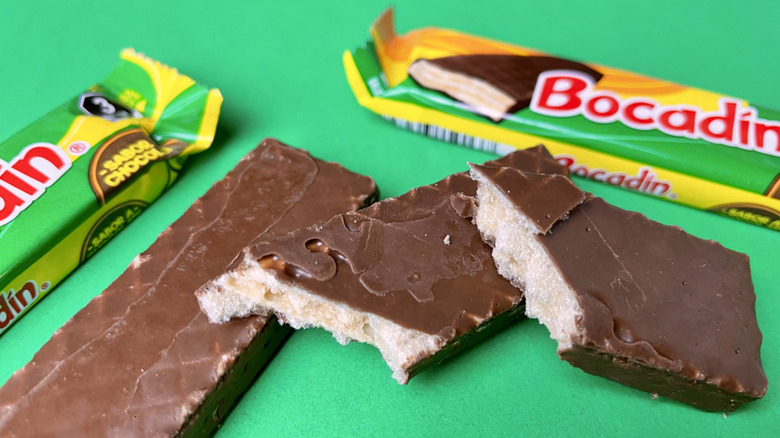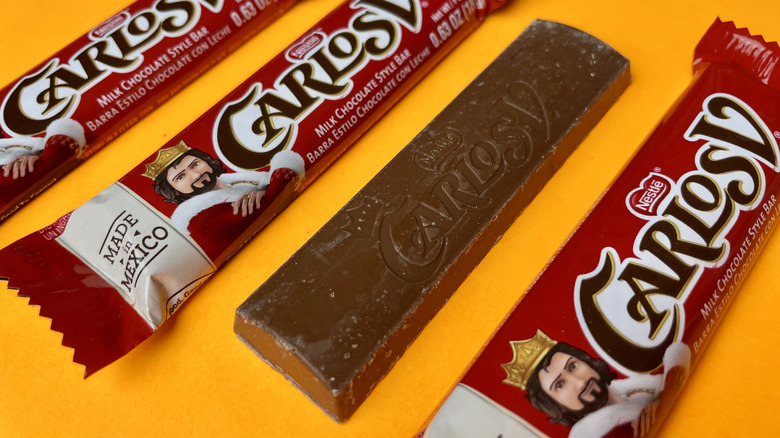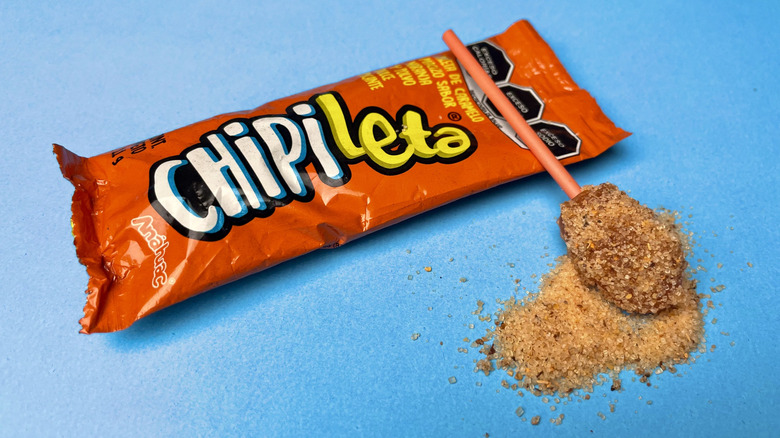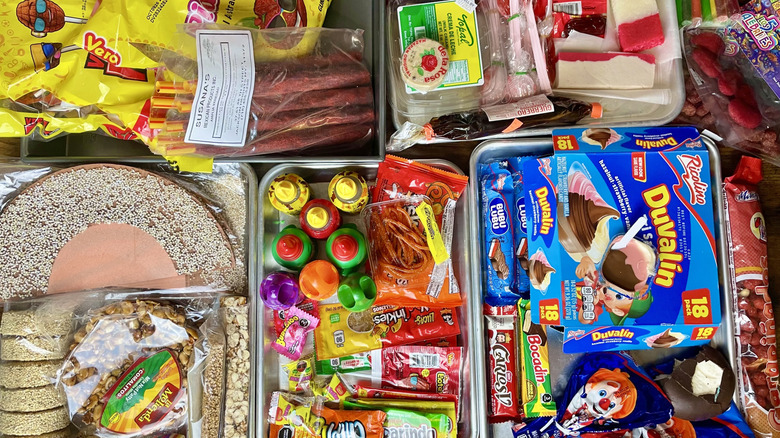The Best Mexican Candies You Should Try At Least Once
It's not often that you get to experience the excitement of being a kid in a candy store as an adult, so when the opportunity presents itself, you should take it. That goes double for when you find yourself in a foreign candy store, filled with treats made with different flavor combinations and ingredients than you're used to back home. Even if you aren't traveling soon, you can stir up that same sense of wonder by trying out some of these popular candies from our neighbors in Mexico.
Even Mexican food lovers may not be intimately familiar with many of the country's popular sweets. Ingredients like tamarind, chili powder, amaranth, and chamoy play a starring role in the wide variety of Mexican candies that rarely appear in American candy-making. From traditional homemade confections to international favorites, here are 25 of the best Mexican candies you should try at least once.
Bubu Lubu
Not only is "Bubu Lubu" really fun to say, but it's one of the many iconic candies from Ricolino — one of the biggest chocolate and candy producers in Mexico. The Bubu Lubu bar is made with a layer of soft marshmallow, topped with a layer of strawberry jelly, and finished with a chocolate candy coating.
A full-sized bar is shaped like a peanut with four humps and looks exactly how I'd imagine the physical manifestation of the name Bubu Lubu to look. Prepare yourself for sticky fingers after enjoying a Bubu Lubu, but it's worth it.
Bocadín
Also produced by Ricolino, the Bocadín bar is an easily enjoyable, straightforward wafer bar, sandwiched with a little bit of peanut butter cream filling, and coated in chocolate. It's similar to what you'd expect from a Little Debbie Nutty Buddy, but quite a bit smaller.
The peanut butter cream filling has a mild peanut flavor bordering on imperceptible, with the chocolate covering providing the most sweetness. Bocadín bars are almost more like cookies thanks to the additional crunchiness, and are great for a lighter bite to satisfy that sweet tooth with a cup of coffee or tea.
Carlos V
Nestlé, known for its chocolate products in both the U.S. and Europe, also produces Carlos V bars in Mexico. The red wrappers feature an illustrated image of a handsome king, which negligibly resembles the actual Carlos V — also known as King Charles I of Spain, and Charles V Holy Roman Emperor from 1519-1556, among other titles.
During his reign, Charles V oversaw the Spanish conquest of Mexico, which resulted in the introduction and proliferation of chocolate to Europe. In the 1970s, La Azteca began producing the Carlos V chocolate bars in Mexico, where the small solid milk chocolate bars are still produced today.
Paleta Payaso
Paleta Payaso means "clown pop," which you can probably deduce by the kid in clown makeup on the pop's wrapper. Unlike the frozen Mexican paletas made with fresh fruit and sometimes dairy, these old-school paletas are made with large, round marshmallows on sticks that have been dipped in a chocolate candy coating, and decorated with two blue candies for eyes and a red candy smile.
Paleta Payaso pops are available in both regular and mini sizes, but despite their ingredients, they aren't especially sweet. The soft and chewy marshmallow inside the pop is unflavored, and the three small gummy candies on top are generically berry-flavored.
Duvalín
Duvalín is the instantly recognizable tiny package of sweet and creamy candy that you eat with an equally tiny plastic spatula (or your finger in a pinch). The small half-ounce plastic pan is filled with a colorful swirl of what tastes like Nutella with vanilla and strawberry frostings.
The Tri Sabor Duvalín includes a Neapolitan-like serving of all three flavors, but you can also find them in the Bi Sabor flavor duos, which include vanilla/hazelnut, hazelnut/strawberry, and strawberry/vanilla combinations. Made by Ricolino, which was purchased by Mondelez in 2022, these popular Mexican treats will likely be available to a wider audience and are relatively easy to find stateside.
Jamoncillo/Crema de Leche
Crema de Leche, or Jamoncillo as it's widely referred to, is known in English as Mexican Milk Fudge. The fudge-like crystallized candy ranges from soft to semi-firm, and occasionally crumbly, depending on how it's cooked. It's made with sugar (either white or brown), milk (regular or sweetened condensed), and occasionally garnished with pecan halves.
While plenty of confectionery companies make Jamoncillo, it's traditionally more of a handmade-style candy, and you're more likely to find it from smaller local or regional producers in your area, than exported from Mexico. It can be found in blocks, bars, squares, tubes, or individually-poured candies, depending on who makes it.
Mazapán
Many Americans are familiar with classic European-style marzipan: a modeling paste confection, usually made with almond paste and powdered sugar, which is often molded into fruits and other small decorations. De la Rosa's founder, Jesús Michel González, took the traditional European recipe for almond marzipan and created mazapán, a peanut-based paste that's made with sugar and pressed into small round pads.
Texturally speaking, De la Rosa's peanut mazapán isn't more crumbly and less pliable than European marzipans, but it's just as sweet. The candy company also makes a version of it that's dipped in chocolate, if you're in the mood for something truly indulgent.
Jamoncillo de Pepita
Jamoncillo de Pepita, or pumpkin seed fudge, is similar to milk fudge in the sense that it's made with sugar and sometimes milk, often sliced into blocks, bars, or squares, and typically handmade by smaller local producers. But what sets it apart is that it also contains pumpkin seeds, which are finely ground into a paste for the fudge, making it similar in texture to the pliable and puttylike European version of marzipan.
Originating in the Puebla region of Mexico, Jamoncillo de Pepita can be more difficult to find the further you are from Mexico. But if you're lucky, you might find a few bars in the refrigerated section of an authentic Mexican grocery store.
Glorias
Of all of the candies made anywhere in the world, Glorias is one of the few I come back to with the same love as the first time I tasted it. Cajeta is a goat's milk caramel, made the same way as dulce de leche, by boiling down milk and sugar until both the added sugars and naturally occurring sugars in the dairy caramelize into a tasty and rich sauce.
Las Sevillanas makes cajeta sauce, which was the inspiration for Glorias candies. Cooked into a caramel candy, and mixed with chopped pecans, these soft caramels have an almost saucy cajeta core that's worth savoring.
Coconut Bandera Bar
Colored like a small, sweet Mexican flag, the coconut bandera (flag) bar is hard to miss and even harder to resist for coconut lovers, strategically placed by the register in many Mexican groceries. You're getting pretty much exactly what you see with these bars: finely shredded coconut, pressed together with sugar, usually some kind of milk for a little extra creaminess and moisture, and a generous helping of food coloring to achieve the patriotic effect. Lovers of coconut macaroons will find these bars downright irresistible, but might not want to enjoy the entire thing in one sitting to avoid a stomachache later on.
Bubbaloo Gum
There are as many types of bubble gum in the world as there are people chewing it, but if you're the kind who reaches for fruit-flavored gum filled with a fruity liquid filling, Bubbaloo gum is one you've got a try. Cadbury is the current producer of Bubbaloo gum, and this was the first chewing gum ever created with a liquid center back in the 1980s.
The gum is still wildly popular, especially in Mexico and Brazil, with a growing worldwide audience, thanks to its international parent companies. The wide variety of flavors includes Tutti Frutti, Banana, Blueberry, Strawberry, Mint, Pineapple Chamoy, Yerba Buena, and Grape, among others.
Chipileta pops
Plenty of fruity American candies are available in both sweet and sour versions, but few come with the additional layers of salty and spicy flavors that so many Mexican candies are made with. If you haven't experienced any of these spicy candies firsthand, imagine having a fruity cocktail garnished with a sweet, salty, and spicy rim.
Chipileta pops (a clever mash-up of "chili" and "paleta") are just the tip of the spicy candy iceberg. Available in orange, watermelon, and chamoy flavors, each pop comes covered with a chili powder sugar, in a bag with extra chili-sugar for dipping once you've finished off what came on the pop.
Pica Fresa
Vero is one of the larger, most recognizable candy companies in Mexico, responsible for an impressive array of spicy candy offerings. One of the most popular of those candies is Pica Fresa, "pica" short for picante (spicy), and fresa being the Spanish word for strawberry. Each individually-wrapped Pica Fresa candy is about the size of an extra-small strawberry, with a textured surface that's coated with a spicy and sour layer, which gives way to an ultra-sweet, powerful strawberry-flavored gummy candy. It's an absolute flavor-bomb for all of the senses, which you might find yourself impulsively wanting to revisit after the first try.
Pulparindo
De la Rosa isn't the only candy company that makes tamarind fruit leather, but the brand's Pulparindo bars are one of the most popular options. Like spicy candy, tamarind-flavored candy isn't very prevalent in the U.S., but it is found in a substantial amount of Mexican candies.
The original Pulparindo flavor has a straightforward list of ingredients, including sugar, real tamarind pulp, iodized salt, citric acid (for an extra sour kick), and ground guajillo chili for a little bit of heat. Other flavors include mango, watermelon, chamoy, extra spicy, sugar-free, and chili-free tamarind pulp bars.
Paletas con Chili
Similar to Chipileta pops, Vero also produces an assortment of lollipops that are either coated or filled with chili powder. This assortment includes mango pops with chili powder, which is a popular flavor regardless of which brand of pop you're buying.
Elote pops are shaped like tiny ears of corn, but are actually strawberry flavored with chili powder coating. The Sandi Brochas pop is watermelon flavored and filled with chili powder, and the Trabalenguas pop is a combination of watermelon, strawberry, and mango flavors, filled with chili powder instead of coated.
Rellerindos
One of my favorite tamarind-flavored candies also happens to be one of the most difficult to eat, but it's always worth it. Shaped like a small tamarind pod, Rellerindos are a hard candy that's sweet and acidic on the outside, hiding a softer chili pepper filling within.
After a few minutes of sucking on the tamarind candy, I can never resist the urge to bite through the hard shell to get to the mildly spicy soft core and enjoy the extra pop of flavor within. Before you even pop one in your mouth, make peace with the fact that you'll be sucking sticky candy bits out of your teeth for a little while afterwards, and enjoy it while it lasts.
Gusano
Lucas is a popular Mexican candy brand that makes a variety of spicy and playful candies. Gusano (strangely, meaning "worm") is a line of liquid candy that's mostly fruity and sweet, but packs a little bit of chili heat and sour candy flavor as well.
It comes in a small squeeze bottle that looks like a puffy paint bottle, and can be eaten as-is, or squirted onto fruit or other snacks, or into drinks. Unlike other candies, Gusano doesn't include real fruit, but the tamarind and chamoy flavors are widely available. Although not as easy to find this side of the border, Gusano can also be found in green apple, fuego (fire), and sour flavors.
Pelo Rico
Similar to Lucas' Gusano candy but popular in its own right, Pelon's Pelo Rico is a soft, gel-like candy that's a bit thicker than the Gusano liquid candy, but still very soft. You dispense the spicy candy like you would a push-pop, making strands of thick candy "pelo" (hair) come out of the pelon (bald) top of the container.
The classic Pelo Rico is tamarind flavor, but while it still tastes like tamarind, it doesn't contain any actual tamarind fruit. It does, however, contain chili powder made with peanuts, which contributes to the candy's flavor and texture. Pelo Rico can also be squeezed onto snacks and into drinks for an extra kick.
Skwinkles
Another popular offering from the Lucas collection of candies is the Skwinkles lineup of gummy candies. There are three types of Skwinkles, including the playfully funny Salsaghetti, wider filling-stuffed Rellenos gummy noodles, and the bite-size Chunks that also have a soft candy filling. Each of the noodle-like gummies is offered in some variation of tamarind, mango, watermelon, and pineapple, and has varying degrees of spiciness.
The thin Salsaghetti noodles are sweet, with a small amount of seasoning clinging to the noodles. But what makes the candy especially entertaining is that it's packaged in a small plastic container that serves as your "pasta bowl," and includes a small packet of Lucas' tamarind-flavored Gusano candy that you can pour over the noodles like a sauce.
Cucharita Tamarindo
Cucharita Tamarindo is made by countless brands and small producers, but you'll get a similar candy with most mainstream options. The spoon holds a tamarind candy that's usually more like crystallized sugar than smooth caramel, and is easy to enjoy when you're in the mood for a little bite of sweetness when walking back from the store.
Chili spice level varies by brand, but more often than not, it's a mild heat that allows the sweet and sour flavors of the tamarind candy to shine through. Each spoon is wrapped in plastic wrap, and you can usually find them near the register at a Mexican grocery store, with two spoons bundled together.
Muecas
Think of a Muecas sort of like a Fun Dip, except in this case the sugar stick is a fruity flavored lollipop and the sweet dipping sugar is a zesty and spicy chili powder mix. The Muecas lollipop is set into the lid of the small tube container, which holds the spicy powder for convenient dipping while you continue to enjoy the pop.
Currently available in six flavors, including chamoy, tamarind, mango, watermelon, cherry, and curiously ... cucumber. If you'd like to skip the lollipop altogether and head straight for the spicy powder, Lucas also makes those in mango, chamoy, and watermelon flavors.
Banderillas
Banderillas Tamarindo are long straws that are covered with subtly sweet, super tangy tamarind pulp, and rolled in chili powder. The tamarind pulp isn't usually very sticky, thanks to the chili powder coating, nor is it overwhelmingly sweet. The natural sweetness of the tamarind fruit shines through, followed by a bold tartness, added salt, and a strong and low chili heat.
While banderillas are considered candy, the sweetness of this treat can easily be overshadowed by the tartness or chili powder heat level, which varies depending on the brand that produced it. They can be used as a garnish for drinks, like micheladas, or enjoyed with fresh fruit for an additional pop of sweetness.
Palanquetas
Palanquetas, or Mexican peanut brittle, can be found pretty much anywhere Mexican-style snacks are sold, including U.S. grocery stores that keep a decent selection of Mexican products in stock. Made with peanuts alone, or a mix of peanuts and seeds, palanquetas are often served sliced into bars, or poured into rounds of brittle that have been flattened while the caramel is still hot off the stove. Mixed nut palanquetas will be different from brand to brand, but often include pumpkin or squash seeds, sesame seeds, puffed amaranth, and occasionally dried fruits.
Alegrías de Amaranto
Amaranth isn't often found in mainstream American cooking, but the puffed ancient grain appears regularly in Mexican cooking, both savory and sweet. Alegrías de Amaranto (meaning "joy of amaranth") are honey-sweetened little cakes, like rice cakes but made with puffed amaranth seeds.
The amaranth cakes aren't hard like brittle, but pliable like Rice Krispies treats. Regularly referred to simply as Alegría, the scent of honey wafts off these treats, while the nutty, earthy, and vegetal flavors of the puffed amaranth take center stage. Alegría can generally be found in precut bars, stacks of smaller rounds, or larger rounds sliced into wedges.
Obleas
Obleas are thin, round wafers, most often made with wheat flour, water, corn oil, and sometimes food coloring, and typically don't have any flavor on their own. But sandwiched with cajeta (goat's milk caramel), dulce de leche, chocolate, sweetened condensed milk, or jam, obleas are transformed into an absolutely irresistible treat.
Available in a huge range of sizes and colors, unfilled obleas are sold in stacks and are often miniature to palm-sized rounds. Prefilled obleas, like the cajeta-filled obleas from Las Sevillanas, come in various sizes from mini to medium. Larger format obleas are sliced or folded in half, typically sandwiching chocolate or caramel, and garnished with chocolate, amaranth, or nuts, and sold by street vendors and specialty grocers alike.
Tasting Methodology
New York City is a long way from Mexico, but luckily, there are plenty of expats and Mexican enclaves filled with specialty foods and groceries to offer up a taste of some of Mexico's most popular sweets. The candies featured here are just a fraction of what's available, and narrowing it down to only 25 was more difficult than I thought it would be.
After visiting several local stores to scout out what was available, I ran my shopping list by friends in Mexico, Texas, New York, and Southern California with their own first-hand candy experiences. When they chimed in with nostalgic stories about childhood birthday parties, after-school treats, and the occasional guilty pleasures, that was the sign that a particular candy had to make the list, in addition to my personal favorites.


























